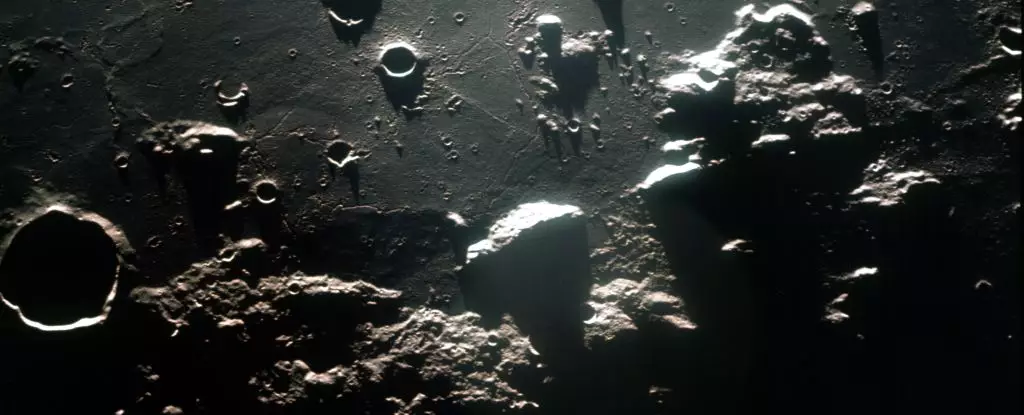The Moon, often viewed as a barren landscape, might hold far more secrets than initially assumed, especially regarding the presence of water and hydroxyl—two critical components that point to the Moon’s potential for supporting life, research, and future exploration. An extensive analysis undertaken by scientists analyzing mineralogical maps has unveiled significant findings: water and hydroxyl are distributed across various locations on the Moon, contradicting the long-held belief that these resources are limited primarily to polar regions. A deeper dive into these discoveries reveals not only the geological implications but also the possibilities for future human endeavors on our celestial neighbor.
Challenging Preconceptions of Lunar Water
For decades, the dominant narrative was that the Moon was largely devoid of water, existing as a dry and inhospitable environment. This perspective, however, has shifted due to comprehensive studies indicating that water is actually stored in the mineral composition of the Moon’s soil. The contemporary research led by planetary scientist Roger Clark from the Planetary Science Institute suggests that water and hydroxyl can be found in various areas across all lunar latitudes—even in regions typically exposed to the harsh rays of the Sun.
Previously, scientific consensus pointed toward the polar craters, deeply sheltered from sunlight, as the prime habitat for water reserves. Clark’s findings challenge these notions, demonstrating that astronauts venturing into the Moon’s equatorial zones may also find significant deposits of water. The implications of this discovery are enormous: not only does it shed light on the Moon’s geological history, but it also opens up viable locations for future human expeditions aiming to utilize lunar resources.
The Moon’s Geological Dynamics
Despite its reputation, the Moon’s geological framework contains hidden features that facilitate the presence of water. Recent investigative work has outlined how water gets trapped in pyroclastic deposits—rock fragments produced during volcanic eruptions, as well as in the material scattered around impact craters. This water is not present as liquid, but rather bound within minerals that characterize the lunar landscape.
Using data collected from the Moon Mineralogy Mapper aboard India’s Chandrayaan-1 spacecraft, researchers have managed to observe the infrared light spectra of the Moon’s surface. This information reveals a pattern indicating the widespread presence of water and hydroxyl, although their concentrations vary across the lunar surface. These findings tease apart the complex geological history of the lunar surface, underscoring not only the water-rich mineral deposits but also the forces that have shaped the Moon’s landscape over millions of years.
However, the tale doesn’t end with the discovery of these resources. The research team highlighted a crucial aspect of the lunar environment: while water might be present in the mineral matrix of lunar soils, it is not static. Water molecules that may be exposed to the harsh solar environment can deteriorate over extended periods due to radiation from solar winds. Interestingly, this exposure ultimately results in the formation of hydroxyl, a common molecule that may serve as a more stable metric for understanding the water’s presence.
Moreover, the study points out that impact events can unearth this water-rich material, sparking a cycle of exposure, destruction, and renewal. Understanding this dynamic process has substantial implications; it gives insight into how water resists the extreme conditions of the Moon and offers astrobiologists a glimpse at possible mechanisms that could support life.
Beyond just water analysis, the inquiry sheds light on some ongoing mysteries of the lunar surface, such as the enigma of the lunar swirls—unique, streak-like formations that scientists have yet to fully decode. Clark’s team discovered that these swirls are notably poor in water, leading to a reevaluation of their origins and what they might reveal about the Moon’s geological past. Interestingly, areas devoid of visible swirls still exhibit water-deficient signatures, suggesting that such features could be remnants of past geological activity, altering our understanding of lunar erosion and sedimentation patterns.
Additionally, an analysis of pyroxene, an igneous rock common on the Moon, has unveiled how its water signatures can change depending on sunlight angles and conditions. This variability provides clues to the movement of water molecules on the lunar surface and helps clarify how water interacts dynamically with the Moon’s harsh environment.
This emergent understanding of lunar water has far-reaching implications for future missions seeking to establish a permanent human presence on the Moon. A practical takeaway from the findings is the possibility that astronauts could extract water from the lunar soil, particularly from hydroxyl-rich minerals. This suggests a future where lunar expeditions are not merely short-term adventures but are instead sustainable endeavors enabled by harnessing the resources that lie beneath the delicately powdered lunar surface.
The uncovering of water and hydroxyl across diverse regions of the Moon revolutionizes our understanding of this celestial body. As research continues to unveil the geological complexities of our nearest neighbor, the prospect of lunar exploration thrives, modified by possibilities unimagined just a few years ago. The Moon may no longer be just a desolate rock; it could very well become a vital hub for humanity’s future in space.

